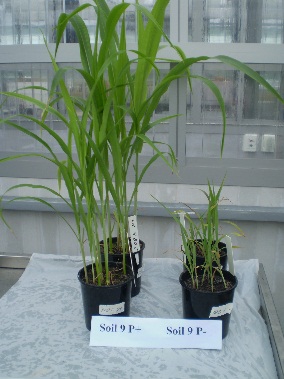Soil fertility
To be healthy, plants need a steady supply of nutrients from the soil.
Required in relatively large quantities are macronutrients:
- nitrogen (N)
- phosphorus (P)
- potassium (K)
- sulphur (S)
- calcium (Ca)
- magnesium (Mg).
Other nutrients are required in small quantities. They are known as micronutrients or trace elements and include:
- copper (Cu)
- zinc (Zn)
- iron (Fe)
- manganese (Mn)
- boron (B)
- molybdenum (Mo).
A shortage or absence of any one of these essential nutrients can severely affect plant growth. Too much of any nutrient can also be as bad as too little.
Contributing factors
The availability of nutrients is affected by the pH of the soil. For example in very acid soils, manganese and aluminium may be present in toxic concentrations.

The nutrient status of a soil can be determined by a laboratory analysis of the soil or by tissue analysis of the plants that grow in it.
A soil’s natural fertility depends largely on the parent materials from which the soil has developed and the original vegetation. Nutrients are held in the soil as electrically charged ions that can be positive (cations) or negative (anions).
As roots grow through the soil, they come into contact with cations and anions (held on the soil or dissolved in water) and the nutrients are actively taken up by the plant.
The amounts of nutrients available in soils depend on interactions between:
- soil properties—pH, texture and different clay minerals can have an influence on soil fertility
- soil biology—organisms living in the soil break down animal and plant matter into nutrient forms that can be used by plants
- soil organic matter—important for holding nutrients until they can be taken up by plants
- soil water—water in soil pores carries the nutrients to plant roots
- fertilisers—an excess of a particular nutrient can impede the uptake of others.
Importance of soil fertility
In all agricultural systems, significant quantities of nutrients are removed over time in harvested products.
Off-site losses of nutrients can also occur through soil erosion, runoff, leaching and burning of crop residues.
Gaseous losses of nitrogen may occur through denitrification and volatilisation.
The usual management response to nutrient removal or loss is to apply fertiliser.
When nutrient removal exceeds nutrient inputs, the soil's nutrient reserves are depleted and eventually crop yields decline.
When nutrient inputs exceed crop demands, soil nutrient levels increase. Off-site nutrient movement may then occur, causing pollution of groundwater and surface water due to nitrogen and phosphorus being present in runoff and attached to sediments.